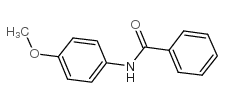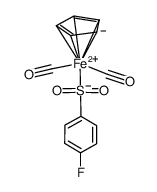38117-54-3
| 中文名 | 环戊基铁(II) 二羰基二聚体 |
|---|---|
| 英文名 | Cyclopentadienyliron dicarbonyl dimer |
| 中文别名 | 四羰基双(环戊二烯基)二铁 |
| 英文别名 |
MFCD00001436
dicarbonylcyclopentadienyliron dimer |
| 熔点 | 194ºC (dec.)(lit.) |
|---|---|
| 分子式 | C14H10Fe2O4 |
| 分子量 | 353.91700 |
| 精确质量 | 353.92800 |
| LogP | 1.20600 |
Synonym:None Known Section 2 - COMPOSITION, INFORMATION ON INGREDIENTS
Risk Phrases: 20/21/22 Section 3 - HAZARDS IDENTIFICATION EMERGENCY OVERVIEW
Harmful by inhalation, in contact with skin and if swallowed.The toxicological properties of this material have not been fully investigated. Potential Health Effects Eye: May cause eye irritation. Skin: May cause skin irritation. Ingestion: May cause irritation of the digestive tract. May cause cardiac disturbances. The toxicological properties of this substance have not been fully investigated. May cause central nervous system depression. Inhalation: May cause respiratory tract irritation. The toxicological properties of this substance have not been fully investigated. May cause cardiac abnormalities. Inhalation at high concentrations may cause CNS depression and asphixiation. Chronic: No information found. Section 4 - FIRST AID MEASURES Eyes: Flush eyes with plenty of water for at least 15 minutes, occasionally lifting the upper and lower eyelids. Get medical aid. Skin: Get medical aid. Flush skin with plenty of water for at least 15 minutes while removing contaminated clothing and shoes. Wash clothing before reuse. Ingestion: Never give anything by mouth to an unconscious person. Get medical aid. Do NOT induce vomiting. If conscious and alert, rinse mouth and drink 2-4 cupfuls of milk or water. Inhalation: Remove from exposure and move to fresh air immediately. If not breathing, give artificial respiration. If breathing is difficult, give oxygen. Get medical aid. Notes to Physician: Section 5 - FIRE FIGHTING MEASURES General Information: As in any fire, wear a self-contained breathing apparatus in pressure-demand, MSHA/NIOSH (approved or equivalent), and full protective gear. During a fire, irritating and highly toxic gases may be generated by thermal decomposition or combustion. Containers may explode when heated. Non-combustible, substance itself does not burn but may decompose upon heating to produce irritating, corrosive and/or toxic fumes. Runoff from fire control or dilution water may cause pollution. Extinguishing Media: Use water spray to cool fire-exposed containers. Do NOT get water inside containers. Do NOT use straight streams of water. For small fires, use dry chemical, carbon dioxide, or water spray. For large fires, use water spray, fog or regular foam. Section 6 - ACCIDENTAL RELEASE MEASURES General Information: Use proper personal protective equipment as indicated in Section 8. Spills/Leaks: Vacuum or sweep up material and place into a suitable disposal container. Clean up spills immediately, observing precautions in the Protective Equipment section. Avoid generating dusty conditions. Provide ventilation. Section 7 - HANDLING and STORAGE Handling: Wash thoroughly after handling. Use with adequate ventilation. Minimize dust generation and accumulation. Avoid contact with eyes, skin, and clothing. Keep container tightly closed. Avoid ingestion and inhalation. Storage: Store in a tightly closed container. Store in a cool, dry, well-ventilated area away from incompatible substances. Section 8 - EXPOSURE CONTROLS, PERSONAL PROTECTION Engineering Controls: Facilities storing or utilizing this material should be equipped with an eyewash facility and a safety shower. Use adequate ventilation to keep airborne concentrations low. Exposure Limits CAS# 38117-54-3: Belgium - TWA: (listed as iron salts (soluble)): 1 mg/m3 VLE (as Malaysia: (listed as iron salts (soluble)): 1 mg/m3 TWA (as Fe) Netherlands: (listed as iron salts (soluble)): 1 mg/m3 MAC (as Fe Spain: (listed as iron salts (soluble)): 1 mg/m3 VLA-ED (as Fe) Personal Protective Equipment Eyes: Wear appropriate protective eyeglasses or chemical safety goggles as described by OSHA's eye and face protection regulations in 29 CFR 1910.133 or European Standard EN166. Skin: Wear appropriate protective gloves to prevent skin exposure. Clothing: Wear appropriate protective clothing to prevent skin exposure. Respirators: Follow the OSHA respirator regulations found in 29 CFR 1910.134 or European Standard EN 149. Use a NIOSH/MSHA or European Standard EN 149 approved respirator if exposure limits are exceeded or if irritation or other symptoms are experienced. Section 9 - PHYSICAL AND CHEMICAL PROPERTIES Physical State: Crystals Color: dark purple Odor: None reported. pH: Not available. Vapor Pressure: Not available. Viscosity: Not available. Boiling Point: Not available. Freezing/Melting Point: 194 deg C dec Autoignition Temperature: Not applicable. Flash Point: Not applicable. Explosion Limits, lower: Not available. Explosion Limits, upper: Not available. Decomposition Temperature: Solubility in water: insoluble Specific Gravity/Density: Molecular Formula: C14H10Fe2O4 Molecular Weight: 353.92 Section 10 - STABILITY AND REACTIVITY Chemical Stability: Stable under normal temperatures and pressures. Conditions to Avoid: Incompatible materials, dust generation, excess heat, strong oxidants. Incompatibilities with Other Materials: Oxidizing agents. Hazardous Decomposition Products: Carbon monoxide, irritating and toxic fumes and gases, carbon dioxide. Hazardous Polymerization: Has not been reported. Section 11 - TOXICOLOGICAL INFORMATION RTECS#: CAS# 38117-54-3 unlisted. LD50/LC50: Not available. Carcinogenicity: Cyclopentadienyliron Dicarbonyl Dimer - Not listed by ACGIH, IARC, or NTP. Section 12 - ECOLOGICAL INFORMATION Section 13 - DISPOSAL CONSIDERATIONS Dispose of in a manner consistent with federal, state, and local regulations. Section 14 - TRANSPORT INFORMATION IATA Shipping Name: METAL CARBONYLS, N.O.S.* Hazard Class: 6.1 UN Number: 3281 Packing Group: III IMO Shipping Name: METAL CARBONYLS, N.O.S. Hazard Class: 6.1 UN Number: 3281 Packing Group: III RID/ADR Shipping Name: METAL CARBONYLS, N.O.S. Hazard Class: 6.1 UN Number: 3281 Packing group: III Section 15 - REGULATORY INFORMATION European/International Regulations European Labeling in Accordance with EC Directives Hazard Symbols: XN Risk Phrases: R 20/21/22 Harmful by inhalation, in contact with skin and if swallowed. Safety Phrases: S 28A After contact with skin, wash immediately with plenty of water. S 36/37 Wear suitable protective clothing and gloves. S 37 Wear suitable gloves. S 45 In case of accident or if you feel unwell, seek medical advice immediately (show the label where possible). WGK (Water Danger/Protection) CAS# 38117-54-3: No information available. Canada None of the chemicals in this product are listed on the DSL/NDSL list. CAS# 38117-54-3 is not listed on Canada's Ingredient Disclosure List. US FEDERAL TSCA CAS# 38117-54-3 is not listed on the TSCA inventory. It is for research and development use only. SECTION 16 - ADDITIONAL INFORMATION N/A |
| 危害码 (欧洲) | Xn: Harmful; |
|---|---|
| 风险声明 (欧洲) | 20/22 |
| 安全声明 (欧洲) | 36/37 |
| 危险品运输编码 | UN 3466 6.1/PG 3 |
| 包装等级 | III |
| 危险类别 | 6.1(b) |
| 上游产品 0 | |
|---|---|
| 下游产品 10 | |




![N-[4-(Trifluoromethyl)phenyl]benzamide结构式](https://image.chemsrc.com/caspic/246/350-98-1.png)






